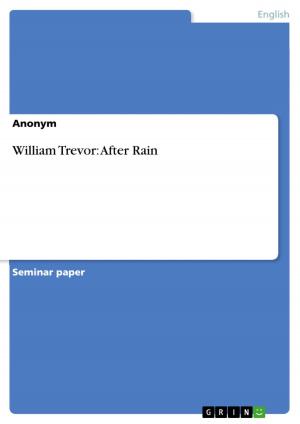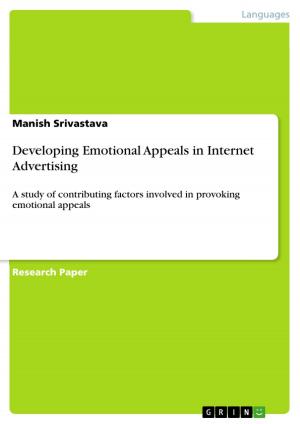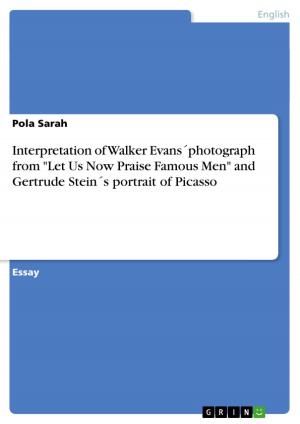The Novel 'Tsotsi' and its Adaptation on Film
Fiction & Literature, Literary Theory & Criticism, British| Author: | Uwe Mehlbaum | ISBN: | 9783640829163 |
| Publisher: | GRIN Publishing | Publication: | February 14, 2011 |
| Imprint: | GRIN Publishing | Language: | English |
| Author: | Uwe Mehlbaum |
| ISBN: | 9783640829163 |
| Publisher: | GRIN Publishing |
| Publication: | February 14, 2011 |
| Imprint: | GRIN Publishing |
| Language: | English |
Seminar paper from the year 2010 in the subject English Language and Literature Studies - Literature, grade: 1,3, University of Bayreuth (Anglophone Literaturen und Kulturen ), course: HS Africa on Film, language: English, abstract: 1. Introduction2 2. Athol Fugard as a writer and the historical context2 3. Tsotsi as a novel and Tsotsi as a film - a direct comparison3 3.a. General differences3 3.a.1. Narrators in novels and pictures in films3 3.a.2. The atmosphere4 3.a.3. The setting4 3.a.4. The language5 3.b. The differences in the plots of the two versions5 3.b.1. Tsotsi's gang and the murder of Gumboot Dhlamini (Chapter 1)5 3.b.2. Tsotsi's fight with Boston (Chapter 2)6 3.b.3. Tsotsi's encounter with the baby (Chapter 3)7 3.b.4. Tsotsi hides the baby in the ruins (Chapter 4)8 3.b.5. The funeral of Gumboot Dhlamini, Boston's recovery and Tsotsi's reunification with Butcher and Die Aap (Chapter 5)9 3.b.6. Tsotsi's encounter with Morris Tshabalala (Chapters 6 and 7)9 3.b.7. Tsotsi finds a replacement mother in Miriam Ngidi (Chapter 8)10 3.b.8. Tsotsi's childhood (Chapter 9)11 3.b.9. Tsotsi's second encounter with Miriam Ngidi (Chapter 10)12 3.b.10. The story of Boston's life (Chapter 11)13 3.b.11. Tsotsi's death (Chapter 12)15 4. Interpretations of the major differences16 4.a. The replacement of the apartheid topic16 4.b. The different atmospheres in the two works17 4.c. The missing narrator and its effect on the plausibility and numerous details18 4.d. Apparent commercial reasons for changes in the plot18 5. Summary19 6. Works cited19 Unlike the novel's plot, the plot of the film is not set in the 1950s to 60s but in the post-apartheid South Africa around the beginning of the new millennium. Not just because more than 40 years passed from the original idea until its publication as a film, the original novel and the film version are quite different in many aspects. Although both the novel and the film follow roughly the same structure, the differences offer many enlightening insights. This paper is going to compare the film version with the original version in the novel in order to analyze and interpret the differences. Some of the major differences revolve around the role of racism, apartheid, politics and social criticism in the two versions, and still others around the different impacts of the two works and the different reasons, purposes and circumstances under which the novel was written and why the film was made.
Seminar paper from the year 2010 in the subject English Language and Literature Studies - Literature, grade: 1,3, University of Bayreuth (Anglophone Literaturen und Kulturen ), course: HS Africa on Film, language: English, abstract: 1. Introduction2 2. Athol Fugard as a writer and the historical context2 3. Tsotsi as a novel and Tsotsi as a film - a direct comparison3 3.a. General differences3 3.a.1. Narrators in novels and pictures in films3 3.a.2. The atmosphere4 3.a.3. The setting4 3.a.4. The language5 3.b. The differences in the plots of the two versions5 3.b.1. Tsotsi's gang and the murder of Gumboot Dhlamini (Chapter 1)5 3.b.2. Tsotsi's fight with Boston (Chapter 2)6 3.b.3. Tsotsi's encounter with the baby (Chapter 3)7 3.b.4. Tsotsi hides the baby in the ruins (Chapter 4)8 3.b.5. The funeral of Gumboot Dhlamini, Boston's recovery and Tsotsi's reunification with Butcher and Die Aap (Chapter 5)9 3.b.6. Tsotsi's encounter with Morris Tshabalala (Chapters 6 and 7)9 3.b.7. Tsotsi finds a replacement mother in Miriam Ngidi (Chapter 8)10 3.b.8. Tsotsi's childhood (Chapter 9)11 3.b.9. Tsotsi's second encounter with Miriam Ngidi (Chapter 10)12 3.b.10. The story of Boston's life (Chapter 11)13 3.b.11. Tsotsi's death (Chapter 12)15 4. Interpretations of the major differences16 4.a. The replacement of the apartheid topic16 4.b. The different atmospheres in the two works17 4.c. The missing narrator and its effect on the plausibility and numerous details18 4.d. Apparent commercial reasons for changes in the plot18 5. Summary19 6. Works cited19 Unlike the novel's plot, the plot of the film is not set in the 1950s to 60s but in the post-apartheid South Africa around the beginning of the new millennium. Not just because more than 40 years passed from the original idea until its publication as a film, the original novel and the film version are quite different in many aspects. Although both the novel and the film follow roughly the same structure, the differences offer many enlightening insights. This paper is going to compare the film version with the original version in the novel in order to analyze and interpret the differences. Some of the major differences revolve around the role of racism, apartheid, politics and social criticism in the two versions, and still others around the different impacts of the two works and the different reasons, purposes and circumstances under which the novel was written and why the film was made.















